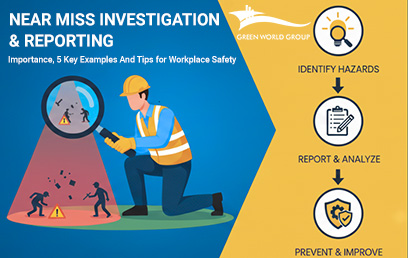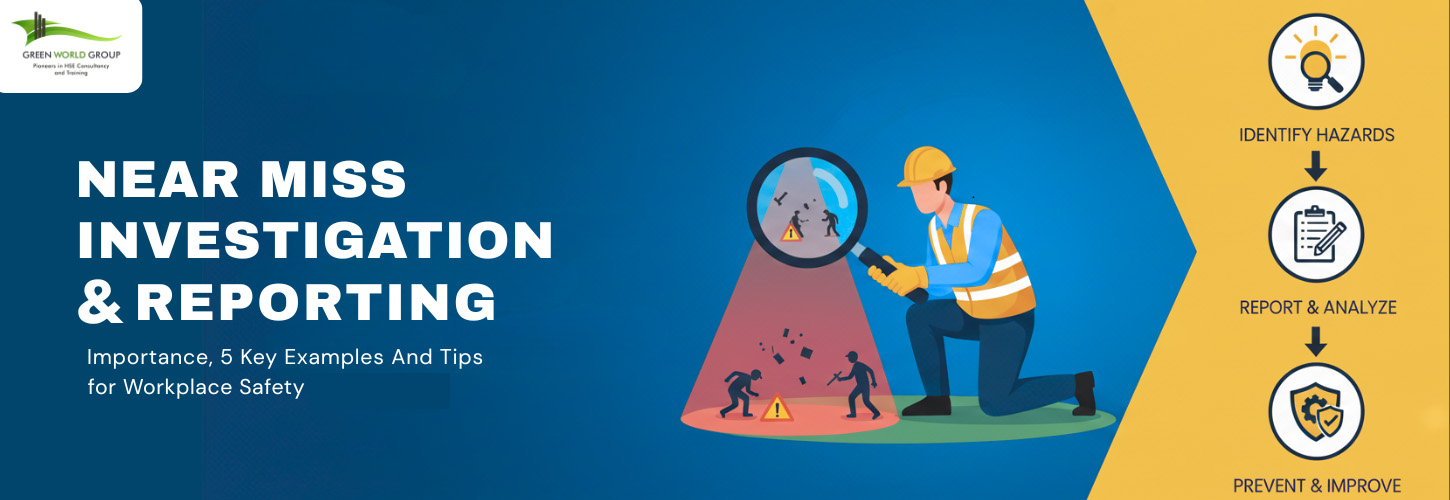
Near Miss Investigation & Reporting: Importance, 5 Key Examples and Tips for Workplace Safety

What is Near Miss & why it should be investigated?
A near miss is an unplanned event where something goes wrong, but no one gets hurt and nothing gets damaged. It’s a close call that shows a danger is present, and if it happens again, it could lead to injury, illness, or major damage.
Near Miss = “Warning Signal” before a real accident
Investigating near misses helps to
 Identify the root causes of accidents, like unsafe acts and conditions, before they cause injury or damage
Identify the root causes of accidents, like unsafe acts and conditions, before they cause injury or damage Implement corrective measures,
Implement corrective measures, Prevent future occurrences
Prevent future occurrences Improve workplace safety performance
Improve workplace safety performance Build a proactive reporting culture
Build a proactive reporting culture Reduce operational and financial losses
Reduce operational and financial losses
Difference between accident and near miss
Both involve safety hazards — but the outcome is what separates them:
 A near miss = injury-free event (risk existed but no harm occurred)
A near miss = injury-free event (risk existed but no harm occurred) An accident = harm, injury, or damage happens
An accident = harm, injury, or damage happens
For Example, A tool falls from height — if it hits no one, it’s a near miss; if it injures someone, it’s an accident.

Essential Steps to follow for an Effective Accident Investigation Process
The purpose of accident investigation is to uncover underlying factors that lead to accidents, enabling organisations to address weaknesses in systems, processes, or behaviours. Let see how to conduct a Step-by- step Incident investigation procedure to ensure workplace Safety are,
Why Do Near Misses Happen: 5 Common Near Miss Examples
Near misses typically occur due to human error, such as poor workplace procedures or a lack of awareness. They can also result from,
 Situations where an injury or property damage was narrowly avoided
Situations where an injury or property damage was narrowly avoided Hazardous site or equipment conditions that could have caused harm
Hazardous site or equipment conditions that could have caused harm Unsafe actions or shortcuts taken during work activities
Unsafe actions or shortcuts taken during work activities Poor or risky work practices observed during operations
Poor or risky work practices observed during operations Incorrect or careless use of tools, machinery, or vehicles
Incorrect or careless use of tools, machinery, or vehicles Faulty, damaged, or malfunctioning equipment that could lead to incidents
Faulty, damaged, or malfunctioning equipment that could lead to incidents Minor injuries or property damage incidents that had the potential to escalate
Minor injuries or property damage incidents that had the potential to escalate
Near Miss Examples in Industrial Settings:
Manufacturing
- A chemical leak makes the floor slippery — a worker almost falls, but catches their balance. A clear signal that spills are not being reported quickly.


Construction
- A crane load suddenly slips and drops nearby. No one is hurt, but the scare shows the lifting equipment needs urgent checking.

Work at Height
- A roofer slips while walking, but guardrails save the day. If barriers were missing, this would become a serious accident.


Industrial Machinery / LOTO
- A machine jams, and the operator tries to fix it while it’s still running. Luckily, a colleague stops them just in time — reminding them why LOTO matters.

Storage & Materials Handling
- Heavy boxes fall from the top shelf and land close to a worker. Unsafe stacking could have caused a serious head injury.

The Roles and Responsibilities of an Employees
Every near miss is a valuable warning — a chance to fix what could lead to a serious accident. It signals the gap in safety systems or procedures that needs immediate attention. Every employee has a responsibility to identify and manage near misses by:
 Reporting any near miss as soon as it occurs, with clear and accurate details
Reporting any near miss as soon as it occurs, with clear and accurate details Staying alert to unsafe acts, conditions, or potential hazards in the Workplace
Staying alert to unsafe acts, conditions, or potential hazards in the Workplace Following safety procedures and looking out for the safety of coworkers
Following safety procedures and looking out for the safety of coworkers Taking quick action to reduce risks when possible and informing supervisors immediately
Taking quick action to reduce risks when possible and informing supervisors immediately
What is Near Miss Report and its importance:
A Near Miss Report records an incident that could have caused harm but didn’t. It explains what happened, why it occurred, and what actions are needed to prevent it from happening again.
Importance of Near Miss Reporting:
Statistics show that for every 300 near-miss events, 29 minor injuries and 1 serious injury are likely to happen if no action is taken. This clearly proves that every unreported near miss is a future accident waiting to happen.
Reporting near misses helps organisations to:
 It establishes safe practices and reduces risks before incidents occur.
It establishes safe practices and reduces risks before incidents occur. It allows easy information sharing and collects valuable data to prevent future hazards.
It allows easy information sharing and collects valuable data to prevent future hazards. It creates opportunities to improve safety operations and avoid complacency in the Workplace.
It creates opportunities to improve safety operations and avoid complacency in the Workplace. It is a useful tool to identify workplace hazards and involve employees in safety improvements.
It is a useful tool to identify workplace hazards and involve employees in safety improvements. It demonstrates management’s commitment to safety and helps identify trends over time.
It demonstrates management’s commitment to safety and helps identify trends over time.
Near Miss Reporting Procedure
Step-by-Step procedure to create an effective Near Miss Report:
 Record the Incident: Note down what happened, the potential risk, and the factors that contributed to the event.
Record the Incident: Note down what happened, the potential risk, and the factors that contributed to the event. Inform Supervisors: Report the near miss immediately to your supervisor or safety team so they can take prompt action.
Inform Supervisors: Report the near miss immediately to your supervisor or safety team so they can take prompt action. Find the Root Cause: Investigate the cause of the incident and identify the factors that contributed to its occurrence, to prevent it from happening again.
Find the Root Cause: Investigate the cause of the incident and identify the factors that contributed to its occurrence, to prevent it from happening again. Apply Corrective Actions: Implement suitable control measures in place to remove or reduce the identified risks.
Apply Corrective Actions: Implement suitable control measures in place to remove or reduce the identified risks. Check Effectiveness: Review if the actions taken have improved safety and prevented recurrence.
Check Effectiveness: Review if the actions taken have improved safety and prevented recurrence. Follow Up and Close: Complete the documentation, review outcomes, and share lessons learned to improve workplace safety.
Follow Up and Close: Complete the documentation, review outcomes, and share lessons learned to improve workplace safety.

Near Miss Reporting Format:
There are several near-miss report templates available online, or you can create a customized version to suit your company’s specific requirements and worksite conditions.
Here’s the key information that should be included in a near-miss reporting form:
 Date of the incident
Date of the incident Location of the incident
Location of the incident Time of observation
Time of observation Description of the situation and conditions
Description of the situation and conditions Possible causes
Possible causes Corrective actions taken
Corrective actions taken Date of completion
Date of completion Signatures of involved personnel
Signatures of involved personnel
Near Miss Report Format by OSHA: Click here
Why Near Misses Go Unreported: How to Increase Near-Miss Reporting in the Workplace
These are the following reasons that people don’t Report Near Misses:
 Fear of blame or punishment.
Fear of blame or punishment. Feeling embarrassed about the incident.
Feeling embarrassed about the incident. Worried about what coworkers will think.
Worried about what coworkers will think. The reporting process is too long or confusing.
The reporting process is too long or confusing. They don’t know how or where to report.
They don’t know how or where to report. There is no proper reporting system in place.
There is no proper reporting system in place. They never see results or follow-up actions.
They never see results or follow-up actions. They don’t feel motivated or encouraged to report.
They don’t feel motivated or encouraged to report. They didn’t realize the situation was dangerous.
They didn’t realize the situation was dangerous.
6 Effective Ways to Strengthen Near-Miss Reporting: Employers Responsibility
1.Promote a Positive Safety Culture
Encourage open, blame-free communication. Appreciate and reward employees who report near misses to build trust and motivate others to participate.
2.Simplify the Process
Make the reporting process quick and convenient by using digital tools, mobile apps, or simple paper forms available at all work areas.
3.Train for Awareness
Conduct regular training sessions to help employees understand what a near miss is and why it’s essential to report. Use real-life examples or case studies to make learning more relatable and engaging.
4.Act Promptly
Respond to every report without delay. Provide feedback so employees can see that their reports lead to real improvements in workplace safety.
5.Lead by Example
Supervisors and managers should openly encourage reporting and discuss near misses during safety meetings to show strong leadership commitment.
6.Allow Anonymous Reporting
Offer confidential or anonymous reporting options to ensure employees feel comfortable sharing incidents, especially in sensitive or high-risk situations.
Final Note
Investigating and reporting near misses turns hidden hazards into lifesaving improvements. With proper safety training, employees learn to identify risks early, report incidents without fear, and take corrective action.
Green World empowers employees to identify hazards, report near misses confidently, and prevent accidents — through globally recognised safety programs like NEBOSH, IOSH, OSHA, ISO, Safety Diploma and customized in-company training solutions.
Speak with our safety experts and build a safer workplace today.


 NEBOSH CERTIFICATE
NEBOSH CERTIFICATE NEBOSH DIPLOMA
NEBOSH DIPLOMA IOSH
IOSH SAFETY DIPLOMA
SAFETY DIPLOMA CPD UK
CPD UK FOOD SAFETY
FOOD SAFETY 



